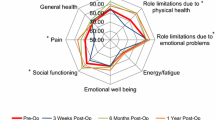Abstract
Purpose
Ventral hernias (VH) are a common surgical problem associated with significant morbidity. While assessment tools have examined quality-of-life (QoL), the relative change in specific domains of hernia-related QoL measures from pre- to post-operative period has yet to be comprehensively examined. Using the Abdominal Hernia-Q (AHQ), this study aims to assess the impact of ventral hernia repair (VHR) on key components of QoL.
Methods
A retrospective chart review was conducted of patients undergoing VHR between September 2017 and September 2019 who had completed at least one pre- and post-operative AHQ. Post-operative intervals were created to capture AHQ responses around standard follow-up visits (< 1.5 months, 1.5–4.5 months, 4.5–11 months, and 11 + months) and scores were statistically analyzed.
Results
A total of 136 patients were included, with an average age of 54.8 years at the time of VHR. Compared to the pre-operative period, the appearance score increased significantly (p < 0.05). The physical domain score increased from < 1.5 month to the 1.5–4.5 month period (p = 0.03) and remained significantly higher in later time period. The appearance score decreased from the 1.5–4.5 month to 4.5–11 month period (p = 0.05).
Conclusions
VHR leads to a sustained multi-dimensional increase in hernia-specific QoL measures during the post-operative course driven by early positive changes in appearance and sustained physical functioning. The initial increase in QoL is mainly driven by an improvement in appearance, while the sustained increase may be due to restored physical function.



Similar content being viewed by others
References
Bilimoria KY, Cella D, Butt Z (2014) Current challenges in using patient-reported outcomes for surgical care and performance measurement: everybody wants to hear from the patient, but are we ready to listen? JAMA Surg 149:505. https://doi.org/10.1001/jamasurg.2013.5285
Grove TN, Muirhead LJ, Parker SG et al (2021) Measuring quality of life in patients with abdominal wall hernias: a systematic review of available tools. Hernia 25:491–500. https://doi.org/10.1007/s10029-020-02210-w
Patel AA, Donegan D, Albert T (2007) The 36-item short form. J Am Acad Orthop Surg 5:126–134. https://doi.org/10.5435/00124635-200702000-00007
Mauch JT, Enriquez FA, Shea JA et al (2020) The Abdominal Hernia-Q: development, psychometric evaluation, and prospective testing. Ann Surg 271:949–957. https://doi.org/10.1097/SLA.0000000000003144
Patel V, Cunning JR, Rios-Diaz AJ et al (2021) Prospective assessment of the Abdominal Hernia-Q (AHQ)-patient burden, reliability, and longitudinal assessment of quality of life in hernia repair. Ann Surg. https://doi.org/10.1097/SLA.0000000000004713
Feng MP, Baucom RB, Broman KK et al (2019) Early repair of ventral incisional hernia may improve quality of life after surgery for abdominal malignancy: a prospective observational cohort study. Hernia J Hernias Abdom Wall Surg 23:81–90. https://doi.org/10.1007/s10029-018-1863-4
Haider S, Wood K, Bui A, Leitman IM (2021) Racial disparities in outcomes after common abdominal surgical procedures—the impact of access to a minimally invasive approach. J Surg Res 257:85–91. https://doi.org/10.1016/j.jss.2020.07.056
Docimo S, Spaniolas K, Yang J, Talamini MA, Pryor AD (2020) Health care disparity exists among those undergoing emergent hernia repairs in New York State. Hernia. https://doi.org/10.1007/s10029-020-02244-0
Hoffman RD, Danos DM, Lau FH (2021) National health disparities in incisional hernia repair outcomes: an analysis of the healthcare cost and utilization project national inpatient sample (HCUP-NIS) 2012–2014. Surgery 169:1393–1399. https://doi.org/10.1016/j.surg.2020.11.028
Olavarria OA, Bernardi K, Dhanani NH et al (2020) Synthetic versus biologic mesh for complex open ventral hernia repair: a pilot randomized controlled trial. Surg Infect 22:496–503. https://doi.org/10.1089/sur.2020.166
Majumder A, Winder JS, Wen Y, Pauli EM, Belyansky I, Novitsky YW (2016) Comparative analysis of biologic versus synthetic mesh outcomes in contaminated hernia repairs. Surgery 160:828–838. https://doi.org/10.1016/j.surg.2016.04.041
Kanitra JJ, Hess AL, Haan PS, Anderson CI, Kavuturu S (2019) Hernia recurrence and infection rate in elective complex abdominal wall repair using biologic mesh. BMC Surg 19:174. https://doi.org/10.1186/s12893-019-0640-3
Funding
John P. Fischer has received payments as a consultant from Becton–Dickinson, Gore, and Integra Life Sciences. This research did not receive financial support for the study.
Author information
Authors and Affiliations
Corresponding author
Ethics declarations
Conflict of interest
The remaining authors do not have any financial disclosures.
Ethical approval
The University of Pennsylvania Institutional Review Board reviewed and approved this study.
Human and animal rights
The study including human participants has been performed in accordance with the ethical standards of the Declaration of Helsinki and its later amendments.
Informed consent
For this study, formal consent was not required.
Additional information
Publisher's Note
Springer Nature remains neutral with regard to jurisdictional claims in published maps and institutional affiliations.
Rights and permissions
About this article
Cite this article
Onyekaba, G., Mauch, J.T., Patel, V. et al. The Abdominal Hernia-Q: a critical analysis of the components that impact quality-of-life. Hernia 26, 839–846 (2022). https://doi.org/10.1007/s10029-021-02475-9
Received:
Accepted:
Published:
Issue Date:
DOI: https://doi.org/10.1007/s10029-021-02475-9




